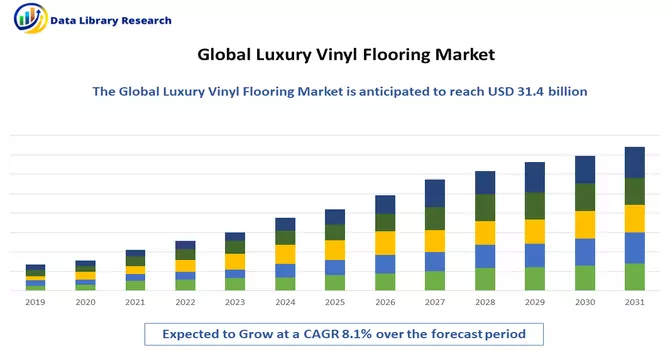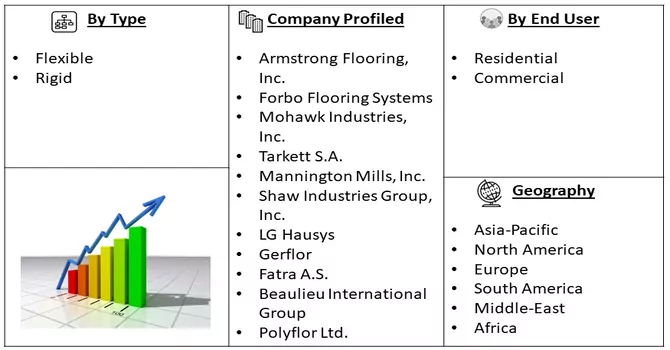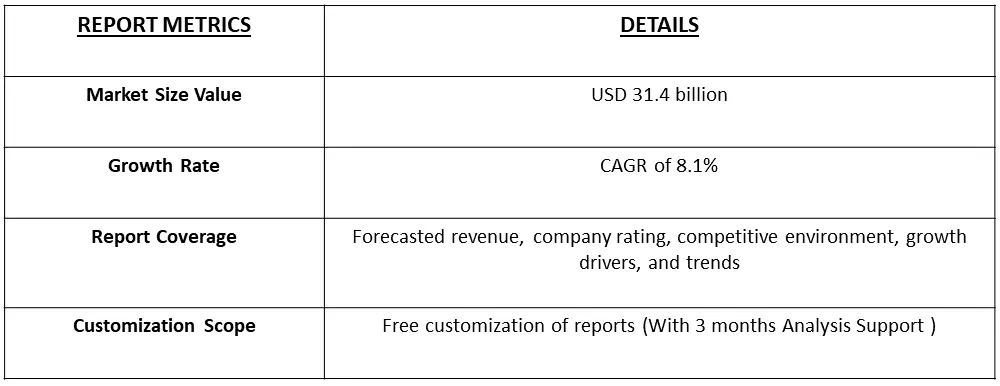The global luxury vinyl flooring market size was estimated at USD 31.4 billion in 2023 and is expected to register a compound annual growth rate (CAGR) of 8.1% during the forecast period, 2024-2031.

Get Complete Analysis Of The Report - Download Free Sample PDF
Luxury Vinyl Flooring (LVT) refers to a high-quality, synthetic flooring material that replicates the appearance of natural materials like wood or stone. It is known for its aesthetic appeal and durability, making it a popular choice for residential and commercial spaces seeking a luxurious and resilient flooring option. Luxury vinyl flooring typically consists of multiple layers, including a wear layer for enhanced durability, a realistic printed design layer that mimics the look of natural materials, and core layers providing structural stability. Additionally, a protective top layer guards against scratches, stains, and wear, ensuring a long-lasting and visually appealing flooring solution. LVT is often available in various patterns, colors, and textures, offering versatility and the ability to suit a wide range of interior design preferences.
The Luxury Vinyl Flooring (LVT) market is experiencing robust growth driven by several key factors. Notably, the durability and longevity of LVT make it an appealing choice for consumers seeking resilient flooring solutions. Its realistic replication of natural materials, coupled with a diverse range of design options, enhances its aesthetic appeal, catering to various interior design preferences. Cost-effectiveness, ease of installation, and low maintenance requirements further contribute to its widespread adoption. Additionally, LVT's water resistance, technological advancements, and environmental sustainability initiatives propel market growth. The rising real estate and construction activities, coupled with expanding distribution channels and increasing use in commercial applications, add to the overall momentum of the LVT market.
The Luxury Vinyl Flooring (LVT) market is witnessing dynamic trends that are shaping the industry landscape. Notable among these is the continuous evolution in design and technology, with manufacturers leveraging advancements in printing technologies to offer more realistic and diverse options. Environmental sustainability is a prominent trend, as the market responds to the increasing demand for eco-friendly flooring solutions, resulting in the development of recyclable and sustainable LVT products. The integration of smart technologies, such as underfloor heating systems and home automation features, is gaining popularity. Customization and personalization are key considerations for consumers, leading to the availability of LVT products that allow for greater design flexibility. Health and wellness concerns are influencing the market, with a focus on antimicrobial and hypoallergenic LVT options. Online sales channels are expanding, reflecting the growing preference for convenient online purchasing. Commercial applications of LVT are on the rise, driven by its durability and design flexibility. Waterproof LVT is increasingly sought after, particularly for moisture-prone areas like kitchens and bathrooms. The global market is experiencing substantial growth, fueled by factors such as urbanization, economic development, and increased adoption in emerging markets. Lastly, collaborations and partnerships between manufacturers, designers, and technology providers are becoming more prevalent, fostering innovation and addressing evolving consumer needs in the competitive LVT market.
Market Segmentation: The Luxury Vinyl Flooring Market is Segmented by Type (Flexible and Rigid) and End User (Residential and Commercial) and by Region (Africa, Asia-Pacific, Europe, Middle East, North America, and South America). Key data points observed include the market volume of end-user segments, per capita consumption, and raw material production.

For Detailed Market Segmentation - Download Free Sample PDF
Market Drivers:
Durability and Longevity
The substantial strength and resilience inherent in Luxury Vinyl Flooring (LVT), which includes its ability to resist wear, scratches, and stains, play a pivotal role as a driving force in the market. Consumers are increasingly attracted to flooring solutions that not only promise aesthetic appeal but also ensure prolonged durability. This inherent robustness becomes a key factor influencing the expansion of the market, as it aligns with consumer preferences for long-lasting performance and durability in their flooring choices. The assurance of enduring quality positions LVT as a compelling option in the competitive landscape of the flooring industry, contributing significantly to its market growth.
Aesthetic Versatility
The compelling emulation of natural materials, combined with a wide array of design choices, attracts consumers in search of visually appealing flooring solutions. The capability of Luxury Vinyl Flooring (LVT) to replicate the aesthetics of hardwood, stone, and other high-end materials stands out as a powerful catalyst for consumer interest. This unique feature not only satisfies the desire for aesthetic richness but also positions LVT as an attractive option for those seeking a sophisticated and visually pleasing ambience in their living or working spaces. The diverse range of design options further enhances the overall appeal, providing consumers with the flexibility to choose flooring that complements their individual style preferences and interior decor schemes.
Market Restraints:
Lack of Biodegradability
The fact that Luxury Vinyl Flooring (LVT) is a synthetic material gives rise to apprehensions regarding its biodegradability. The extended persistence of vinyl-based materials in landfills, coupled with the absence of a biodegradable component, emerges as a significant constraint for consumers with strong environmental consciousness. This concern is particularly impactful as it underscores potential environmental implications associated with the disposal of LVT products, potentially deterring environmentally aware consumers who prioritize the ecological impact of the materials they choose for their living or working spaces. The lack of a natural degradation process in vinyl-based materials poses a notable challenge in aligning with sustainability expectations and may influence purchasing decisions among environmentally conscious individuals.
The COVID-19 pandemic has had a multifaceted impact on the Luxury Vinyl Flooring (LVT) market. While the increased focus on home improvement projects during lockdowns bolstered demand for residential flooring solutions, disruptions in supply chains and manufacturing processes led to temporary challenges for the LVT industry. Fluctuations in construction activities and economic uncertainties affected commercial projects, impacting the demand for LVT in the non-residential sector. The shift towards remote work also influenced consumer preferences, with an emphasis on flooring options that cater to versatile and functional home spaces. Additionally, the pandemic accelerated the adoption of online sales channels for flooring products, including LVT. Despite initial challenges, the industry showcased resilience, and the adaptability of LVT to changing consumer needs and preferences positions it to rebound and thrive in the post-pandemic market landscape.
Segmental Analysis:
Rigid Type Segment is Expected to Witness Significant Growth Over the Forecast Period
Rigid Core Luxury Vinyl Flooring (LVT) represents a notable advancement in the flooring industry, combining the benefits of both luxury vinyl and rigid core technologies. The rigid core, often composed of a sturdy composite material like stone polymer or wood-plastic composite, provides enhanced dimensional stability and durability. This results in a flooring product that is not only highly resistant to wear, scratches, and dents but also suitable for installation in areas with fluctuating temperature and humidity levels. Rigid Core LVT maintains the aesthetic appeal characteristic of traditional luxury vinyl, offering a diverse range of designs that authentically replicate the look and feel of natural materials like wood or stone. Its click-and-lock installation system facilitates ease of installation, appealing to both professional installers and DIY enthusiasts. One of the significant advantages of rigid core LVT lies in its versatility, allowing for installation over various existing subfloors, including concrete and tile. This makes it an attractive option for both residential and commercial applications. Additionally, the rigid core structure minimizes the telegraphing of imperfections from the subfloor, contributing to a smoother and more visually appealing surface. The market for rigid core luxury vinyl flooring has experienced notable growth, driven by consumer demand for a durable, aesthetically pleasing, and low-maintenance flooring solution. As technology continues to advance, manufacturers are constantly innovating to enhance the performance and design options of rigid core LVT, further solidifying its position as a popular choice in the flooring market.
Commercial Segment is Expected to Witness Significant Growth Over the Forecast Period
The commercial use of Luxury Vinyl Flooring (LVT) has witnessed a significant surge in popularity due to its combination of aesthetic appeal, durability, and versatility. LVT has become a preferred choice for various commercial spaces, including offices, retail establishments, hospitality venues, and healthcare facilities. One of the key factors driving the adoption of LVT in commercial settings is its remarkable durability. With a wear-resistant surface layer and the ability to withstand heavy foot traffic, LVT proves to be an ideal solution for spaces that experience high levels of activity. This durability extends the lifespan of the flooring, providing a cost-effective option for commercial property owners. The aesthetic versatility of LVT is another compelling feature for commercial applications. The flooring can authentically mimic the appearance of natural materials like wood or stone, offering a wide range of design options to complement different interior themes. This flexibility allows commercial spaces to achieve a sophisticated and inviting ambiance while maintaining practicality. Ease of maintenance is a crucial consideration in commercial settings, and LVT excels in this aspect. The smooth, impermeable surface of LVT makes it resistant to stains and easy to clean, reducing the time and resources required for upkeep. This feature is particularly advantageous for busy environments such as retail stores and healthcare facilities, where maintaining a hygienic and aesthetically pleasing space is paramount. Furthermore, the installation flexibility of LVT caters to the diverse needs of commercial projects. Whether it's a renovation or a new construction, LVT's ability to be installed over various subfloor types, coupled with its click-and-lock or glue-down installation options, makes it a convenient choice for commercial property owners and contractors. As the commercial use of LVT continues to expand, manufacturers are innovating to introduce new features, such as sound absorption and enhanced slip resistance, to meet the specific requirements of different commercial environments. Overall, Luxury Vinyl Flooring has proven to be a resilient and adaptable solution for commercial spaces seeking a perfect balance of style, durability, and practicality.
Asia-Pacific Region is Expected to Witness Significant Growth Over the Forecast Period
Luxury Vinyl Flooring (LVT) has gained substantial traction in the Asia Pacific region, finding diverse applications across residential, commercial, and hospitality sectors. In residential settings, LVT is increasingly chosen for its ability to emulate the appearance of natural materials like wood and stone while offering enhanced durability and ease of maintenance. The aesthetic versatility of LVT aligns with various interior design preferences in Asian homes, making it a popular flooring choice. In the commercial sector, LVT has become a go-to option for offices, retail spaces, and healthcare facilities across Asia Pacific. The flooring's durability and resistance to wear and stains make it well-suited for high-traffic areas, providing a long-lasting and visually appealing solution. The ease of maintenance is particularly advantageous for businesses in the region, where maintaining a clean and attractive environment is essential. Hospitality and tourism industries in Asia Pacific have also embraced LVT for its ability to create inviting and aesthetically pleasing spaces. The flooring's design flexibility allows hoteliers and restaurant owners to achieve various themes and atmospheres, enhancing the overall guest experience. Additionally, the durability of LVT contributes to its longevity in spaces that cater to a continuous influx of visitors. Asia Pacific's diverse climate conditions, ranging from tropical to temperate, pose unique challenges for flooring materials. LVT's resilience to fluctuations in temperature and humidity makes it an ideal choice for the region, ensuring stability and longevity even in areas with varying environmental conditions. As sustainability becomes a significant consideration across the Asia Pacific region, the introduction of eco-friendly and recyclable LVT options further contributes to the flooring's popularity. Manufacturers are increasingly aligning with green initiatives to meet the evolving preferences of environmentally conscious consumers in the region. Thus, Luxury Vinyl Flooring has found extensive use in Asia Pacific, driven by its aesthetic appeal, durability, adaptability to diverse environments, and the ability to cater to the specific needs of both residential and commercial spaces. As the flooring industry continues to innovate, LVT is poised to maintain its prominent role in shaping interior spaces throughout the dynamic and diverse Asia Pacific region.

Get Complete Analysis Of The Report - Download Free Sample PDF
Major industry participants are strategically concentrating on attaining the most efficient operational costs, elevating the quality of their products, optimizing production output, and acquiring smaller competitors to maintain a strong presence in the fiercely competitive market. These key players are actively engaged in activities such as mergers and acquisitions, forming joint ventures, entering into agreements, and pursuing other strategic initiatives. Additionally, a significant emphasis is placed on substantial investments in research and development to foster innovation in vinyl-based flooring products, a crucial element for players aiming to thrive and endure in the competitive landscape. Some prominent players in the global vinyl flooring market include:
Recent Development:
1) In 2022, INAX, a prominent Japanese brand, initially recognized for supplying terracotta and tiles for the iconic Frank Lloyd Wright-designed Imperial Hotel in Tokyo, aims to reshape perceptions. The brand seeks to inspire its customers to embrace the versatile use of tiles not only in residential spaces but also in diverse commercial environments such as retail, hospitality, and offices. INAX is dedicated to promoting the extensive application of tiles, transcending traditional associations, and fostering a contemporary appreciation for their aesthetic and functional qualities. In the context of the vinyl flooring market, this development could drive manufacturers and consumers to explore flooring alternatives that offer versatility, durability, and aesthetic appeal similar to tiles. Luxury Vinyl Tile (LVT), for example, shares some of the visual characteristics of traditional tiles but comes with additional benefits such as water resistance, easy maintenance, and cost-effectiveness.
2) In 2021, Takett SA successfully launched its groundbreaking iD Revolution® range of vinyl flooring in Japan. Comprising 100% recycled materials and being fully recyclable, this eco-friendly product resonated strongly with the environmentally conscious market. Tarkett's strategic move to introduce sustainable flooring solutions aligned seamlessly with Japan's growing emphasis on environmental responsibility. The innovative features of iD Revolution positioned Tarkett SA as a leader in the Japanese vinyl flooring market, gaining traction among both residential and commercial consumers seeking sustainable and high-quality flooring options.
Q1. What was the Luxury Vinyl Flooring Market size in 2023?
As per Data Library Researchthe global luxury vinyl flooring market size was estimated at USD 31.4 billion in 2023.
Q2. At what CAGR is the luxury vinyl flooring market projected to grow within the forecast period?
Luxury Vinyl Flooring Market is expected to register a compound annual growth rate (CAGR) of 8.1% during the forecast period.
Q3. What are the Growth Drivers of the Luxury Vinyl Flooring Market?
Durability and Longevity and Aesthetic Versatility are the Growth Drivers of the Luxury Vinyl Flooring Market
Q4. Which region has the largest share of the Luxury Vinyl Flooring market? What are the largest region's market size and growth rate?
Asia-Pacific Region has the largest share of the market . For detailed insights on the largest region's market size and growth rate request a sample here.
Data Library Research are conducted by industry experts who offer insight on industry structure, market segmentations technology assessment and competitive landscape (CL), and penetration, as well as on emerging trends. Their analysis is based on primary interviews (~ 80%) and secondary research (~ 20%) as well as years of professional expertise in their respective industries. Adding to this, by analysing historical trends and current market positions, our analysts predict where the market will be headed for the next five years. Furthermore, the varying trends of segment & categories geographically presented are also studied and the estimated based on the primary & secondary research.
In this particular report from the supply side Data Library Research has conducted primary surveys (interviews) with the key level executives (VP, CEO’s, Marketing Director, Business Development Manager and SOFT) of the companies that active & prominent as well as the midsized organization
FIGURE 1: DLR RESEARH PROCESS

Extensive primary research was conducted to gain a deeper insight of the market and industry performance. The analysis is based on both primary and secondary research as well as years of professional expertise in the respective industries.
In addition to analysing current and historical trends, our analysts predict where the market is headed over the next five years.
It varies by segment for these categories geographically presented in the list of market tables. Speaking about this particular report we have conducted primary surveys (interviews) with the key level executives (VP, CEO’s, Marketing Director, Business Development Manager and many more) of the major players active in the market.
Secondary ResearchSecondary research was mainly used to collect and identify information useful for the extensive, technical, market-oriented, and Friend’s study of the Global Extra Neutral Alcohol. It was also used to obtain key information about major players, market classification and segmentation according to the industry trends, geographical markets, and developments related to the market and technology perspectives. For this study, analysts have gathered information from various credible sources, such as annual reports, sec filings, journals, white papers, SOFT presentations, and company web sites.
Market Size EstimationBoth, top-down and bottom-up approaches were used to estimate and validate the size of the Global market and to estimate the size of various other dependent submarkets in the overall Extra Neutral Alcohol. The key players in the market were identified through secondary research and their market contributions in the respective geographies were determined through primary and secondary research.
Forecast Model
